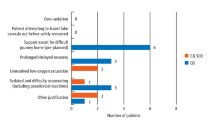Abstract
Background An intravenous sedation (IVS) service was established in 2008 for young people aged 12 years or over, within the paediatric dentistry department at the Eastman Dental Hospital in London. The aim of this study was to carry out a service evaluation and assess the case mix and success rate of this service over the last ten years.
Materials and methods A retrospective service evaluation was carried out, including all patients attending the IVS clinic between April 2009 and March 2019.
Results A total of 457 patients attended over 525 appointments. The mean age was 14. The success rate was over 98%. The average dose of midazolam was 4 mg and dosage ranged from 1.5-10 mg.
Conclusion This IVS service has been established successfully and offers patients an alternative to general anaesthetic. This consequently reduced the general anaesthetic waiting list by 10%.
Key points
-
Intravenous sedation (IVS) is a successful treatment modality in young people.
-
IVS can be used for a variety of dental procedures, including restorations, extractions and surgical procedures such as expose/bonds, surgical removal of teeth and soft tissue surgery.
-
The widespread provision of IVS may ease pressure on dental hospital general anaesthetic waiting lists.
This is a preview of subscription content, access via your institution
Access options
Subscribe to this journal
Receive 24 print issues and online access
$259.00 per year
only $10.79 per issue
Buy this article
- Purchase on Springer Link
- Instant access to full article PDF
Prices may be subject to local taxes which are calculated during checkout



Similar content being viewed by others
References
Lourenço-Matharu L, Roberts G J. Effectiveness and acceptability of intravenous sedation in child and adolescent dental patients: report of a case series at King's College Hospital, London. Br Dent J 2011; 210: 567-572.
Committee on Quality Management and Departmental Administration. Continuum of depth of sedation: definition of general anaesthesia and levels of sedation/analgesia. 2019. Available at https://www.asahq.org/standards-and-guidelines/continuum-of-depth-of-sedation-definition-of-general-anesthesia-and-levels-of-sedationanalgesia (accessed April 2020).
NHS Education for Scotland. Conscious sedation in dentistry: Dental Clinical Guidance (Third Edition). 2017. Available at https://www.sdcep.org.uk/wp-content/uploads/2018/07/SDCEP-Conscious-Sedation-Guidance.pdf (accessed April 2020).
Intercollegiate Advisory Committee for Sedation in Dentistry. Standards for conscious sedation in the provision of dental care. 2015. Available at https://www.saad.org.uk/images/Linked-IACSD-2015.pdf (accessed April 2020).
Ghane M R, Javadzadeh H R, Mahmoudi S, Najafian B, Saburi A. Intramuscular compared to intravenous midazolam for paediatric sedation: A study on cardiopulmonary safety and effectiveness. Afr J Paediatr Surg 2014; 11: 219-224.
Tyagi P, Tyagi S, Jain A. Sedative effects of oral midazolam, intravenous midazolam and oral diazepam in the dental treatment of children. J Clin Paediatr Dent 2013; 37: 301-305.
Joint Formulary Committee. BNF 79. London: BMJ Group and Pharmaceutical Press, 2019.
Papineni McIntosh A, Ashley P F, Lourenço-Matharu L. Reported side effects of intravenous midazolam sedation when used in paediatric dentistry: a review. Int J Paediatr Dent 2015; 25: 153-164.
Weinbroum A A, Szold O, Ogorek D, Flaishon R. The midazolam-induced paradox phenomenon is reversible by flumazenil. Epidemiology, patient characteristics and review of the literature. Eur J Anaesthesiol 2001; 18: 789-797.
Aldrete J A. The post-anaesthesia recovery score revisited. J Clin Anesth 1995; 7: 89-91.
Wilson E, David A, MacKenzie N, Grant I S. Sedation during spinal anaesthesia: comparison of propofol and midazolam. Br J Anaesth 1990; 64: 48-52.
Dental Sedation Teachers Group. DSTG Logbook of clinical experience in conscious sedation. 2020. Available online at https://www.dstg.co.uk/index.php/documents/document/sedationlogbook-doc (accessed April 2020).
Stamp A J, Dorman M L, Vernazza C R et al. Can intravenous conscious sedation with midazolam be effective at facilitating surgical dentistry in adolescent orthodontic patients? A service evaluation. Br Dent J 2017; 222: 113-119.
Royal College of Surgeons of England Faculty of Dental Surgery. The state of children's oral health in England. 2015. Available online at https://www.rcseng.ac.uk/library-and-publications/rcs-publications/docs/report-childrens-oral-health/ (accessed April 2020).
Acknowledgements
Thank you to Professor Paul Ashley for assistance with data collection and analysis. The authors would also like to thank all the dentists, nurses, management and admin team involved in planning and providing this service.
Author information
Authors and Affiliations
Corresponding author
Ethics declarations
The authors declare no conflicts of interest.
Rights and permissions
About this article
Cite this article
Anand, P., Lyne, A., Fulton, A. et al. Service evaluation of an intravenous sedation service within a hospital paediatric dentistry unit: ten-year results. Br Dent J (2021). https://doi.org/10.1038/s41415-020-2596-1
Received:
Accepted:
Published:
DOI: https://doi.org/10.1038/s41415-020-2596-1



